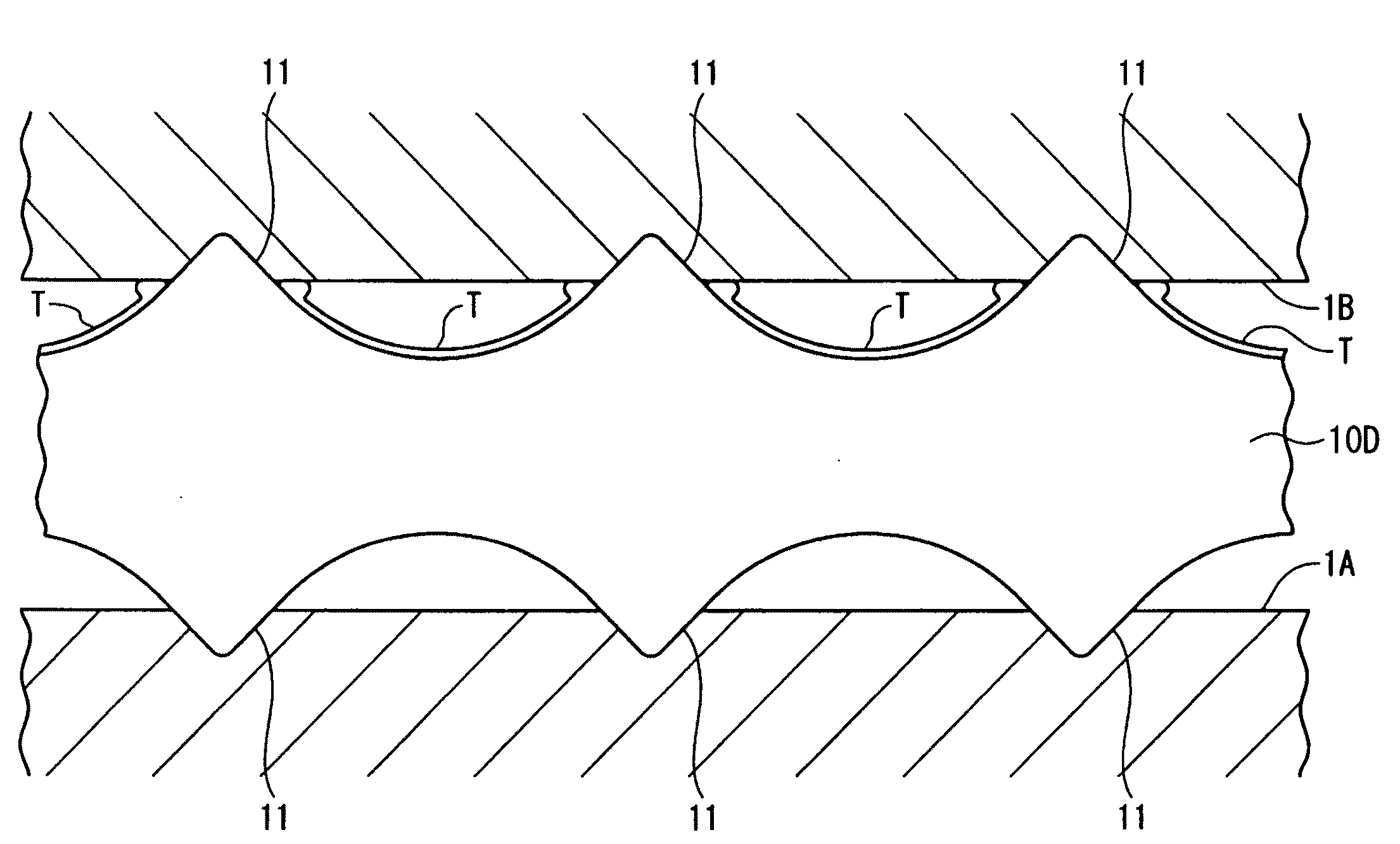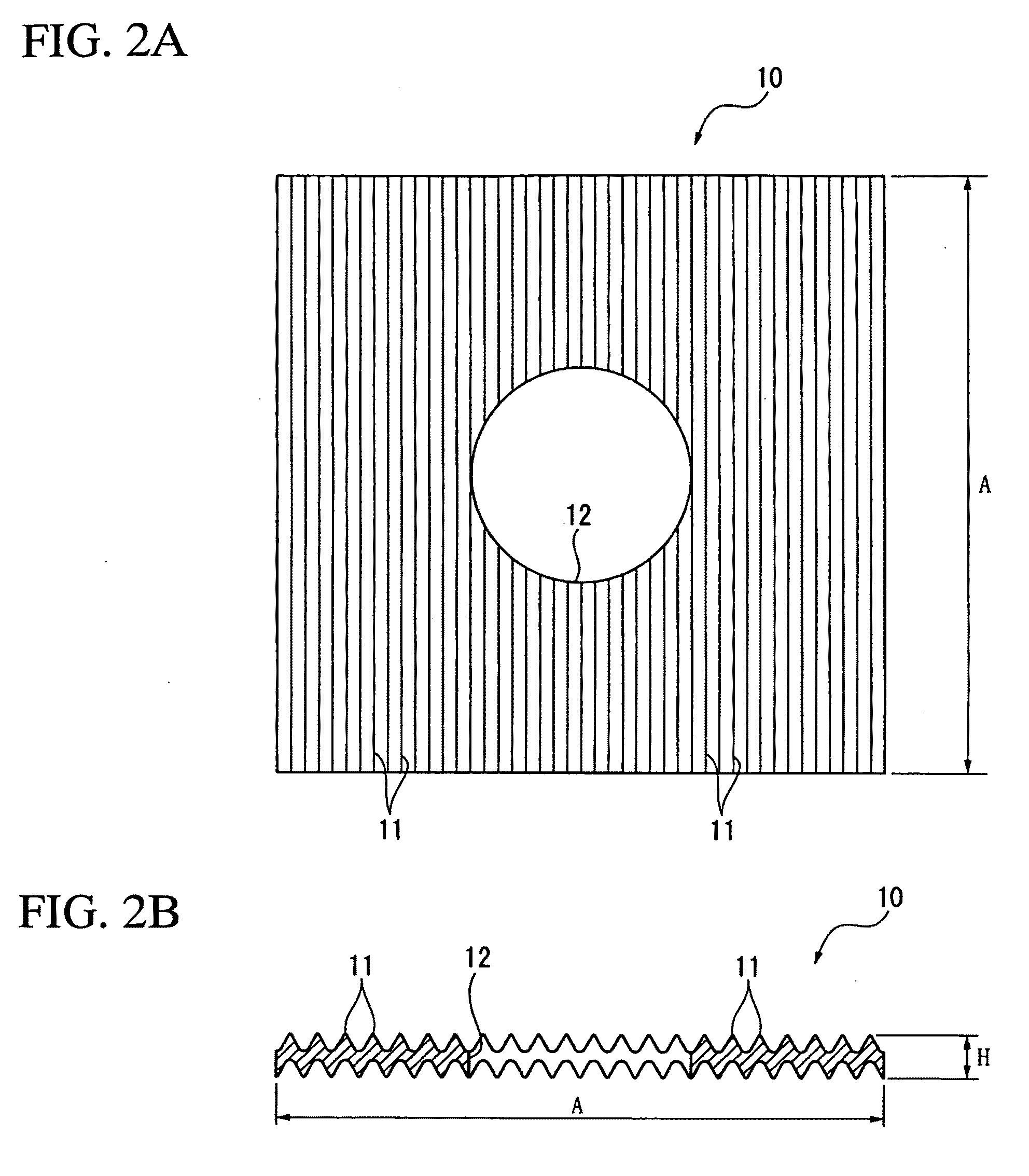Friction-Joining Steel Plate and Friction-Joining Structure
- Summary
- Abstract
- Description
- Claims
- Application Information
AI Technical Summary
Benefits of technology
Problems solved by technology
Method used
Image
Examples
examples
[0100]Hereinafter, a description will be made of an example experimentally verified for the friction-joining structure of the embodiment.
[0101]In the following embodiment, a tensile strength test is conducted in which the friction-joining steel plate 10 and the steel plates 1A and 1B are fastened by using high strength bolts 2A and nuts 2B as illustrated in FIG. 1.
[0102]In this instance, the Vickers hardness ratio (rh) is given as a first parameter, the tip angle (θ) of the projected streaks 11 is given as a second parameter, and the stress intensity ratio (σ / σmb) is given as a third parameter. Then, the tensile strength test is conducted by allowing the three parameters to change, and the thus obtained friction coefficient (slip coefficient) μF is measured
(First Parameter: Vickers Hardness Ratio rh)
[0103]The Vickers hardness ratio rh is a ratio (rh=Hvh / Hvm) of the Vickers hardness (Hvh) at a portion of the projected streaks 11 on the friction-joining steel plate 10 to the Vickers h...
embodiment 1
[0126]FIG. 14 is a photo showing a friction-joining steel plate of Embodiment 1. FIG. 15 is a sectional view illustrating the friction-joining steel plate 10a of Embodiment 1. FIG. 16 is a graph illustrating the test results obtained by using the friction-joining steel plate 10a of Embodiment 1.
[0127]As illustrated in FIG. 15, the friction-joining steel plate 10A of Embodiment 1 is such that the projected streaks 11 are formed symmetrically on the front face and the back face, a space (S) between adjacent projected streaks 11 is set to be about 1.5 mm, and a distance (H) between the tip ends of the projected streaks 11 on the front face and the back face is set to be about 1.5 mm. Further, in the friction-joining steel plate 10a, a tip angle (θ) of the projected streaks 11 is set to be about 90° and a radius (R1) of the tip end portion of the projected streaks 11 is set to be 0.1 mm or less (about 0.1 mm), and a radius (R2) of a recess between the projected streaks 11 is set to be 0...
embodiment 2
[0129]FIG. 17 is a photo showing a friction-joining steel plate of Embodiment 2. FIG. 18 is a sectional view illustrating the friction-joining steel plate 10B of Embodiment 2. FIG. 19 is a graph illustrating the test results obtained by using the friction-joining steel plate 10B of Embodiment 2.
[0130]As illustrated in FIG. 18, the friction-joining steel plate 10B of Embodiment 2 is such that the projected streaks 11 are formed symmetrically on the front face and the back face, a space (S) between adjacent projected streaks 11 is set to be about 0.8 mm, and a distance (H) between the tip ends of the projected streaks 11 on the front face and the back face is set to be about 1.5 mm. Further, in the friction-joining steel plate 10b, a tip angle (θ) of the projected streaks 11 is set to be about 75° and a radius (R1) of the tip end portion of the projected streaks 11 is set to be 0.1 mm or less (about 0.1 mm), and a radius (R2) of a recess between the projected streaks 11 is set to be 0...
PUM
| Property | Measurement | Unit |
|---|---|---|
| Angle | aaaaa | aaaaa |
| Angle | aaaaa | aaaaa |
| Length | aaaaa | aaaaa |
Abstract
Description
Claims
Application Information
 Login to View More
Login to View More - R&D
- Intellectual Property
- Life Sciences
- Materials
- Tech Scout
- Unparalleled Data Quality
- Higher Quality Content
- 60% Fewer Hallucinations
Browse by: Latest US Patents, China's latest patents, Technical Efficacy Thesaurus, Application Domain, Technology Topic, Popular Technical Reports.
© 2025 PatSnap. All rights reserved.Legal|Privacy policy|Modern Slavery Act Transparency Statement|Sitemap|About US| Contact US: help@patsnap.com



